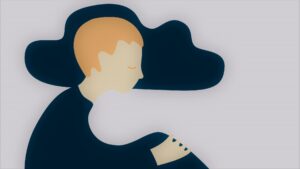Anxiety Disorder
About –
- Anxiety disorder is a mental health condition characterized by persistent, excessive, and irrational fear or worry about everyday situations or activities. It is a common condition that can be highly debilitating, affecting a person’s ability to function in their daily life.
- There are several different types of anxiety disorders, including generalized anxiety disorder (GAD), panic disorder, social anxiety disorder, and specific phobias. Each type of anxiety disorder is characterized by specific symptoms and triggers.
- Symptoms of anxiety disorder may include excessive worry or fear, restlessness, irritability, difficulty concentrating, muscle tension, sweating, trembling, and rapid heartbeat. These symptoms can be mild or severe, and they can interfere with a person’s ability to carry out daily activities and responsibilities.
- Treatment for anxiety disorder may include psychotherapy, medication, or a combination of both. Cognitive-behavioral therapy (CBT) is a common form of psychotherapy used to treat anxiety disorder. It involves working with a therapist to identify negative thought patterns and behaviors and replace them with positive ones.
Medications used to treat anxiety disorder include selective serotonin reuptake inhibitors (SSRIs), benzodiazepines, and beta-blockers. These medications can help to reduce anxiety symptoms and improve a person’s overall quality of life.
If you are experiencing symptoms of anxiety disorder, it is important to seek professional help. With proper treatment, many people with anxiety disorder are able to manage their symptoms and lead fulfilling lives.
Symptoms –
Anxiety disorder can cause a wide range of physical and emotional symptoms, which can vary from person to person. Here are some common symptoms of anxiety disorder:
- Excessive worry or fear: Persistent and excessive worry or fear about everyday situations, events or activities.
- Restlessness: Feeling restless, on edge or keyed up.
- Irritability: Feeling irritable or easily agitated.
- Difficulty concentrating: Finding it hard to concentrate or focus on things.
- Muscle tension: Having tense or tight muscles, especially in the neck, shoulders, and back.
- Sweating: Excessive sweating, especially in the palms or armpits.
- Trembling: Shaking or trembling, especially in the hands or fingers.
- Rapid heartbeat: Heart palpitations, rapid heartbeat or pounding heart.
- Shortness of breath: Feeling like you can’t catch your breath or breathe deeply enough.
- Gastrointestinal issues: Nausea, diarrhea or other digestive problems.
- Sleep problems: Difficulty falling asleep or staying asleep, or having restless or unsatisfying sleep.
- Panic attacks: Sudden, intense bouts of fear or panic that can come on quickly and feel overwhelming.
It’s important to note that everyone experiences anxiety differently, and some people may have different or additional symptoms. If you are experiencing symptoms of anxiety, it’s important to talk to a healthcare professional to determine the best course of treatment.
Causes –
The exact causes of anxiety disorders are not fully understood, but there are several factors that are believed to contribute to their development. Here are some common causes of anxiety disorder:
- Genetics: A family history of anxiety disorders may increase the risk of developing the condition.
- Brain chemistry: Imbalances in certain chemicals in the brain, such as serotonin and dopamine, may contribute to anxiety.
- Trauma and stress: Traumatic or stressful events, such as abuse, neglect, or the death of a loved one, may trigger anxiety symptoms.
- Environmental factors: Living in a high-stress environment or experiencing a significant life change, such as moving or changing jobs, can contribute to anxiety.
- Medical conditions: Certain medical conditions, such as thyroid disorders or heart disease, can cause or worsen anxiety symptoms.
- Substance abuse: Alcohol and drug abuse can lead to anxiety symptoms or worsen existing anxiety disorders.
- Personality traits: Certain personality traits, such as being highly self-critical or having low self-esteem, may increase the risk of developing anxiety disorders.
It’s important to note that anxiety disorders often have multiple causes, and different people may develop the condition for different reasons. If you are experiencing symptoms of anxiety, it’s important to talk to a healthcare professional to determine the best course of treatment.
Types –
There are several different types of anxiety disorders, each with its own set of symptoms and diagnostic criteria. Here are some common types of anxiety disorders:
- Generalized Anxiety Disorder (GAD): This type of anxiety disorder involves persistent and excessive worry about everyday activities, events, or situations, often with no apparent reason. People with GAD may experience symptoms such as restlessness, fatigue, irritability, muscle tension, and sleep problems.
- Panic Disorder: Panic disorder is characterized by sudden and unexpected panic attacks, which are intense episodes of fear or discomfort that can last for several minutes. People with panic disorder may also experience anticipatory anxiety, or fear of having another panic attack.
- Social Anxiety Disorder (SAD): Social anxiety disorder involves intense fear or anxiety about social situations, such as meeting new people, giving a speech, or being in a public place. People with SAD may experience symptoms such as blushing, sweating, trembling, and nausea.
- Specific Phobias: Specific phobias are intense and irrational fears of specific objects or situations, such as heights, spiders, or flying. People with specific phobias may go to great lengths to avoid the feared object or situation.
- Obsessive-Compulsive Disorder (OCD): OCD is characterized by persistent, unwanted, and intrusive thoughts (obsessions) and repetitive behaviors or mental acts (compulsions) that are aimed at reducing anxiety. People with OCD may experience obsessions related to cleanliness, symmetry, or harm, and may engage in compulsive behaviors such as checking, counting, or washing.
- Post-Traumatic Stress Disorder (PTSD): PTSD can develop after a traumatic event, such as military combat, sexual assault, or a natural disaster. People with PTSD may experience symptoms such as flashbacks, nightmares, and intense anxiety or distress when reminded of the traumatic event.
It’s important to note that some people may experience symptoms of multiple types of anxiety disorders, and the specific type of anxiety disorder can only be diagnosed by a qualified healthcare professional.
Treatment –
The treatment of anxiety disorders usually involves a combination of therapies, such as psychotherapy, medication, and lifestyle changes. Here are some common treatments for anxiety disorder:
- Cognitive-behavioral therapy (CBT): This type of therapy helps people learn how to recognize and change negative thought patterns and behaviors that contribute to anxiety. CBT can be done individually or in a group setting.
- Medication: Antidepressants and anti-anxiety medications, such as selective serotonin reuptake inhibitors (SSRIs) and benzodiazepines, can be effective in treating anxiety disorders. However, medication should be used under the supervision of a healthcare professional.
- Relaxation techniques: Techniques such as deep breathing, progressive muscle relaxation, and yoga can help reduce anxiety symptoms and promote relaxation.
- Exercise: Regular exercise can help reduce anxiety and improve overall mental health.
- Lifestyle changes: Limiting caffeine and alcohol intake, getting enough sleep, and eating a healthy diet can help reduce anxiety symptoms.
- Exposure therapy: This type of therapy involves gradually exposing a person to the feared object or situation in a safe and controlled environment, helping them to learn that the feared object or situation is not actually dangerous.
- Support groups: Joining a support group for people with anxiety disorders can provide a sense of community and support.
It’s important to note that treatment for it may be different for each individual, and some people may require a combination of therapies to manage their symptoms. If you are experiencing symptoms of anxiety, it’s important to talk to a healthcare professional to determine the best course of treatment for you.
Diagnosis –
The diagnosis of its typically involves a comprehensive evaluation by a qualified healthcare professional, such as a psychiatrist or psychologist. Here are some common steps involved in the diagnosis of anxiety disorders:
- Medical history: The healthcare professional will ask about your medical history, including any medications or supplements you are currently taking.
- Psychological evaluation: The healthcare professional will ask about your symptoms and any triggers that may contribute to your anxiety.
- Diagnostic criteria: The healthcare professional will use criteria from the Diagnostic and Statistical Manual of Mental Disorders (DSM-5) to determine if your symptoms meet the criteria for a specific anxiety disorder.
- Physical exam: The healthcare professional may perform a physical exam to rule out any medical conditions that may be causing or contributing to your anxiety symptoms.
- Psychological tests: The healthcare professional may administer psychological tests, such as questionnaires or assessments, to help with the diagnosis.
- Collaborative approach: In some cases, the healthcare professional may collaborate with other healthcare providers, such as a primary care physician or a neurologist, to help with the diagnosis and treatment of the anxiety disorder.
It’s important to note that the diagnosis of it can be complex, and it’s important to seek help from a qualified healthcare professional if you are experiencing symptoms of anxiety. A proper diagnosis can help guide the appropriate treatment for your individual needs.


